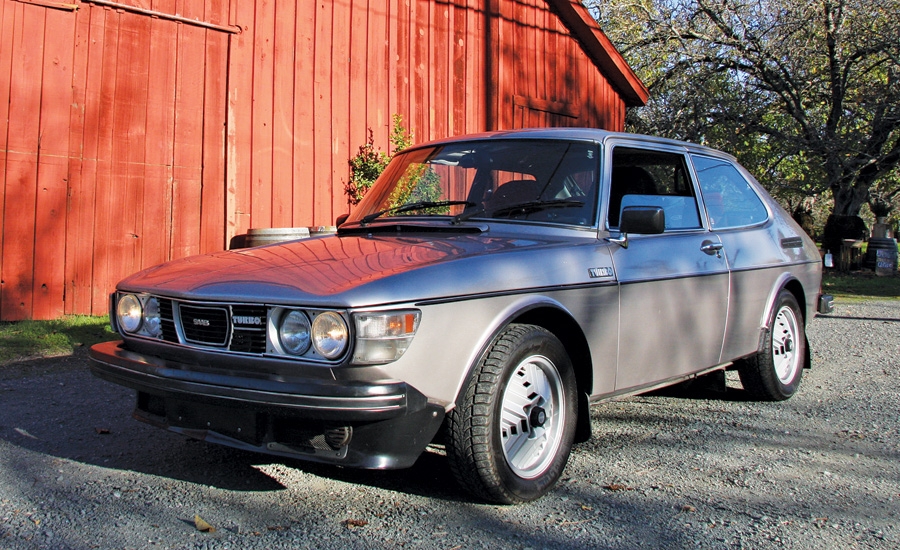
When you think of sports sedans from the late 1970s, the first name that comes to mind probably isn’t the Saab 99 Turbo — unless you have past experience in one.
If you do, they tend to gnaw at you like the prom queen that got away, the early Apple stock you decided not to buy or the chance you passed up to live in Europe with that girl from college.
But climb into a well-loved example today, and you might be tempted to turn back the clock and go all Swedish on us.
Saab started out as an aircraft builder, cranking out fighter planes for neutral Sweden in the late 1930s, you know, just in case, despite every hope of staying out of the war. Seeing the end of hostilities on the horizon, management figured that adding a passenger car to the portfolio would be smart business.
They already had plans in place before 1945 to build their version of the German DKW, which had been the hot seller in pre-war Sweden. Saab planned a two-stroke, front-wheel-drive car with a focus on an aerodynamic body (see: airplanes, above).
Responsible fun
Twenty years later, after a string of modest successes producing staid sedans, it was time to get with the performance program, get with the Swinging ’60s — but in a sober, responsible, safe way. That meant more horsepower, but while the end of the under-powered, unpopular two-stroke was a given, their belief in FWD never wavered.
The Saab 99 body style, an upgrade and brand-new platform from the glaringly old-school and flat-dowdy Saab 96, debuted in late 1967. But the early cars, while handsome, still suffered in the engine bay. The first effort was an anemic 4-cylinder engine built in cooperation with Triumph, followed by several progressively stouter versions, including the EMS launched in 1972.
If you can’t find a Turbo, the 99 EMS is another model to consider. It came with electronic fuel injection, was only offered in the two-door version, and featured a stiffer suspension and got 108 horsepower out of a 1,985-cc engine.
Before the introduction of the Turbo, Saab was known primarily as a safe snow car. The aeronautical engineers who cross-pollinated the aircraft and automotive units brought strong structural integrity with them.
Saab even ran ads to demonstrate how safe they were by showing the car being dropped on its roof, which their rally driver, Stig Blomqvist, accidently demonstrated (IRL, as the kids say) on more than one occasion. But the notion of going inverted with no more ill effects than the need to buff out the roof and get all the loose change and petrified French fries out of your ears isn’t exactly an enthusiast selling point.
Saab’s four-wheeled fighter
The Saab world, and the sport sedan world, changed dramatically when the Turbo was launched in 1978. Now sporting 145 horsepower, it had a top speed of 125 mph, a quiet, comfortable interior and sure-footed handling. In a world of rear-wheel-drive sport sedans, the Saab stood out as a front-wheel-drive, fast alternative, complete with four-wheel discs, tight rack-and-pinion steering and, for the period, a spritely 0–60 time of 9.5 seconds. All at about 22 miles per gallon of pre-embargo go-go juice.
The introduction of the Turbo, with a responsive, smart turbocharger (managed with a nifty exhaust pressure-driven waste-gate) that was tractable and pulled like a pair of Clydesdales headed for the barn had enthusiasts sit up and notice. Even in the racing world, Saab Turbos had their share of successes, quite often here in the U.S. in the hands of FWD showroom stock specialist Don Knowles.
Sit in a Saab 99 Turbo and the first impression is all airplane cockpit, harkening back to Saab’s beginnings, with the instruments neatly arrayed around you, including that nifty boost gauge, which showed up to seven pounds of boost. The view through the flowing windshield, looking over the long hood, was a seat worth scalping. The fact that it was tossable fun, with or without snow, added to the appeal.
Still, never the most popular
However, the 99 Turbo didn’t sell well, even with an original list price just a nickel under $10,000. You see, the new 900 (a more refined car) was already on the way, which cut into sales, which led to price cuts of almost 20% on the Turbos still headed for showrooms.
Even today, the market for the Saab 99 Turbo lags behind the competition. Fanboys love them, but that isn’t enough to nudge prices much higher. That, coupled with serious parts shortages for things such as water pumps and windshields — as well as the fragile transmissions — means the market stays restricted to folks in the “always wanted one, once had one, gotta have another” crowd.
And while waving at BMWs in the rear-view mirror and wicked amounts of torque steer might be appealing, and the entry fee for owning a good example is low, beware the high maintenance costs (when the Turbo fails, expect a $4,000 service bill).
On the bright side, if you put a Saab 99 Turbo on the roof at a local rally, you can probably just buff that out. ♦
